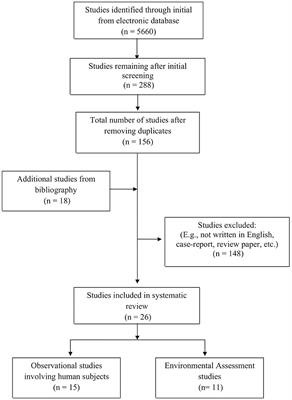Background: Sewage workers have a higher risk of exposure to various potential occupational respiratory hazards found in sewage plants. Although previous studies discuss occupational respiratory hazard concentration impacting sewage workers' respiratory health, the results are scarce and mixed. Hence, there is a need to identify the potential respiratory hazards in sewage plants so as to clarify the short- and long-term respiratory health effects. Therefore, this systematic review (SR) aims to critically rev iew previous studies investigating potential respiratory hazards found at sewage plants and their effects on sewage workers' respiratory health.
Methods: An SR was conducted using PubMed, EBSCO Medline, Web of Science, Scopus, and Google Scholar on peer-reviewed studies published between January 1994 and October 2020 evaluating the impact of potential exposure to respiratory hazards and its effects on respiratory health among sewage workers. "Sewage treatment plant," "respiratory hazards," and "respiratory health effects" were the three main search terms chosen in this SR. The inclusion criteria were (1) studies on potential occupational respiratory hazard exposure among sewage workers, (2) manuscripts written in English, and (3) studies published in the peer-reviewed literature. The human observational studies' quality was assessed using the Effective Public Health Practice Project Quality Assessment Tool.
Results: We identified 5,660 articles through an ini tial database search. Only 26 items met the inclusion criteria and were included in this review; 15 human observational studies and 11 environmental assessment studies were conducted in the sewage industries. Most of the human observational studies were rated as moderate quality, two studies were rated as weak quality, and one study with strong quality was identified. Hydrogen sulfide, bioaerosols, particulate matter 2.5 (PM 2.5), and volatile organic compounds (VOC) were found to be potential respiratory hazards. Most of the risks contributed to adverse outcomes on the sewage workers' respiratory health with some inconsistent findings on the relationship between respiratory hazard exposure and respiratory health effects.
Conclusion: Our review finds that, although this area is of great importance, quality studies are still lacking. There is a need for additional studies to clarify the effects of respiratory hazard exposure on sewage workers and respiratory health, especially PM 2.5 and VOC.



Δεν υπάρχουν σχόλια:
Δημοσίευση σχολίου